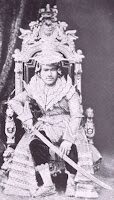Sunday Deposed Monarch Blogging: House Konbaung
 Maung Aung Zeya was born in the village of Moksobo around 1714. His family enjoyed considerable local stature, and Maung Aung Zeya rose to the position of headman at a young age. The previous Burmese dynasty was in decline, and was overthrown in 1752 by a combination of outside invaders and internal rebels. Rather than surrender to the new forces, Maung Aung Zeya fortified his village and prepared a defense. Four attempts to capture the village failed, and the chieftain took advantage of the disarray of his enemies to build up support in the countryside. By 1753, Maung Aung Zeya could exercise control over much of what would become modern Burma, and changed his name Alaungpaya (meaning Future Buddha King). More campaigning in 1755 left Alaungpaya substantially without internal rivals. In 1759 Alaungpaya invaded Siam, but his good fortune did not hold; while besieging the city of Ayutthaya, a gun exploded near the king, mortally wounding him.
Maung Aung Zeya was born in the village of Moksobo around 1714. His family enjoyed considerable local stature, and Maung Aung Zeya rose to the position of headman at a young age. The previous Burmese dynasty was in decline, and was overthrown in 1752 by a combination of outside invaders and internal rebels. Rather than surrender to the new forces, Maung Aung Zeya fortified his village and prepared a defense. Four attempts to capture the village failed, and the chieftain took advantage of the disarray of his enemies to build up support in the countryside. By 1753, Maung Aung Zeya could exercise control over much of what would become modern Burma, and changed his name Alaungpaya (meaning Future Buddha King). More campaigning in 1755 left Alaungpaya substantially without internal rivals. In 1759 Alaungpaya invaded Siam, but his good fortune did not hold; while besieging the city of Ayutthaya, a gun exploded near the king, mortally wounding him.
The Konbaung Dynasty was characterized by ill-defined succession rules and Kings with enormous numbers of wives and children. Bodawpaya, the third of Alaungpaya’s sons to succeed to the throne, had 207 wives and 120 children. Many of the wives were the widows of previous monarchs. The Konbaung fought, often successfully, against the Thai and Chinese empires, and substantially defined the borders of modern Burma. The real threat, however, came from the West; French and British influence in Indochina grew during the eighteenth and nineteenth centuries, and began to threaten the foundations of the monarchy. Wars in 1824 and in 1852 resulted in territorial loss for Burma, but left the kingdom substantially independent. Efforts by King Mindon Min, who ascended to the throne in 1853, to modernize the country bought time for the dynasty.
 In 1878 Mindon Min died and was succeeded by Thibaw Min, one of his 110 children. Thibaw decided that the antidote to the British threat was greater French influence. The British, unsurprisingly, didn’t care for this attitude, and in 1885 a dispute between Thibaw and the British escalated into general war. The conflict was brief, and the British had overwhelming superiority. The British captured Thibaw and his immediate family, exiling him, one wife, and two daughters to India. Given a small pension, the former King and his family would live out the rest of their lives in poverty. King Thibaw died in 1916, at age 58.
In 1878 Mindon Min died and was succeeded by Thibaw Min, one of his 110 children. Thibaw decided that the antidote to the British threat was greater French influence. The British, unsurprisingly, didn’t care for this attitude, and in 1885 a dispute between Thibaw and the British escalated into general war. The conflict was brief, and the British had overwhelming superiority. The British captured Thibaw and his immediate family, exiling him, one wife, and two daughters to India. Given a small pension, the former King and his family would live out the rest of their lives in poverty. King Thibaw died in 1916, at age 58.
The Konbaung Dynasty almost died out in India, but one of the King’s surviving daughters had children who lived. The children have lived at various times in India and Thailand, but now mostly seem to live in Burma. During the Japanese occupation of Burma in the 1940s, some thought was given to restoring the Konbaung to the throne, but difficulties with the collaborator government and the difficult of determining the appropriate heir forced the Japanese to abandon the idea. The current claimant to the throne is Edward Taw Phaya, born in 1924 and grandson to King Thibaw. Prospects for a return to the throne are very grim, as the military junta in Burma has displayed little interest in the royal family, and it is unlikely that any revolutionary government would want to restore the throne.
Trivia: The last monarch of what country shares an important political distinction with Abraham Lincoln…. other than assassination?


